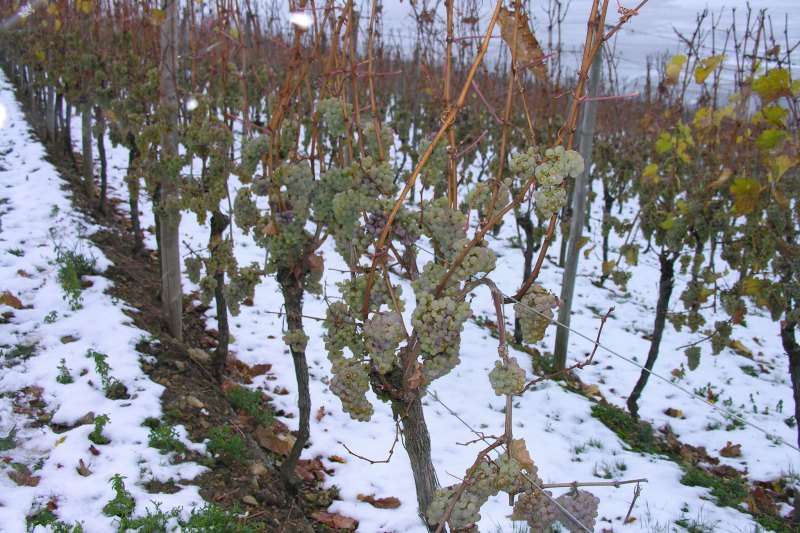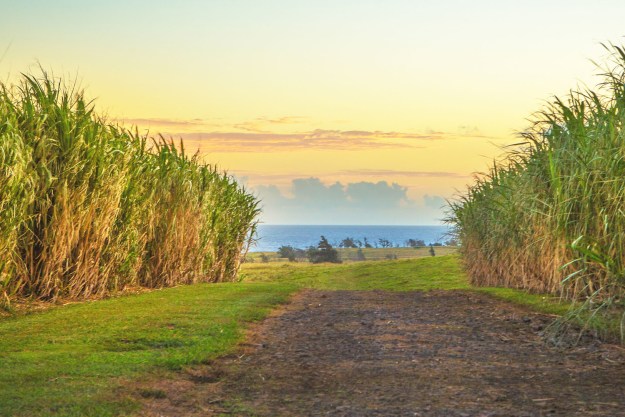If you’re unfamiliar with ice wine, the term may immediately bring to mind images of large glasses of white zin, filled with clinking ice cubes, enjoyed by older ladies with lipstick on their teeth. That’s not ice wine. That’s something else for another day.
Ice wine is a somewhat rare, deliciously exquisite dessert wine that’s created by allowing grapes to freeze before harvest. The result is a tantalizingly, not-at-all-cloying, delectably sweet wine that’s made and enjoyed in the chillier climates around the world.

What is ice wine?
When most agricultural products get hit with an early frost, the entire crop can be lost. But for many winemakers, a deep frost is viewed as an opportunity. Ice wine (or eiswein, as the Germans and Austrians who created the category call it) is a delicate dessert wine that is uniquely delicious and worth the time and added expense.
As a rule, wine grapes aren’t ready to harvest until the fall — sometime between September and November for the Northern Hemisphere, depending on the variety and what sort of balance between acids and sugars the winemaker seeks (think green bananas versus very ripe bananas). Over the centuries, winemakers discovered that you can leave the grapes hanging around even longer, and though they’ll look like little raisins, they create a concentrated, sugary, fermentable juice that’s tasty in its own right, creating a wide variety of sweeter “late harvest” wines.

How is ice wine made?
Delaying the harvest increases the risk of potentially damaging frosts — however, just the right amount of freeze results in a deliciously unique wine. In late 1700s Europe, thanks to the Little Ice Age and its long, bone-chilling winters, Germany started producing the first contemporary ice wines. They also set up rules:
- The grapes had to come in above a certain minimum sugar content.
- You couldn’t pick grapes and pop them in a freezer or set them out some other day to freeze.
- The freezing, which crystallizes water and further concentrates the juice, had to happen naturally.
- The grapes had to be harvested below a specific temperature.
The downside to this approach, especially as Europe thawed in the 19th century (and today as climate change messes with absolutely everything), is you can’t always be guaranteed the right cold weather at the right time. This means that you’ll only get to make eiswein in certain years. In fact, according to Ernst Büscher of the German Wine Institute, due to climate change, “The chances to harvest eiswein are getting lower, which makes German eiswein even more precious. From the 2017 vintage, we do not expect much eiswein, if any.” Despite all this, Büscher said there’s no initiative to relax the rules.
Enter Canada, where it’s always cold. The late Karl Keiser, winemaker for Ontario-based Inniskillin, is credited with bringing Canadian ice wine to the international stage in the 1980s and ’90s. Ironically, Canada’s rules are even stricter than Germany’s — higher minimum sugar levels in the grapes — and winemakers tend to harvest at an even lower minimum harvest temperature. Yet Canada (and the neighboring Niagara Falls and Finger Lakes region of New York state) manages to produce ice wines almost every year.
The process is very similar to that of regular winemaking, except the frozen grapes are very quickly picked and pressed, which makes for ice wine’s signature high sugar content. The resulting ice wine is luscious and sweet and enjoyed all around the world.
There’s even a celebration: the Niagara Icewine Festival, which takes place over three weekends each January. “What makes our festival pretty unique is that we’re able to produce ice wine in quantities that are envied around the world,” said Anthony Annunziata, executive director of Tourism Partnership of Niagara. “The only way to sample this many wines and ice wines at once is to visit each winery, which would take a lot longer. Though it would be very fun.”

How is ice wine classified?
There are ice wines in each of the four general wine classifications, including red, white, rose, and sparkling, so you’re sure to find one that you enjoy.
Most ice wines are made from white grapes because of their bright acidity, but more and more winemakers are starting to experiment with red varietals as well. Cabernet Franc, for example, works beautifully as an ice wine and takes on an entirely different flavor profile due to the skins left on during the fermentation process. Other grapes that grow well in cold climates include merlot, Gewürztraminer, riesling, Grüner Veltliner, and chenin blanc.
Some things to know about ice wine:
- It’s sweet, but not too sweet: Since the sweetness comes from the grapes themselves without any additional sugars, the result isn’t syrupy or cloying. It’s a clean, tight, light sweetness that pairs particularly well with cheeses, fruits, and nuts. According to Scott McGregor, winemaker at Canada’s Lakeview Wine Co., “Great ice wine has a delicate balance of sweetness and acidity, with concentrated flavors.”
- It’s slightly more expensive than regular wines: In ice winemaking, only grapes that are susceptible to harsh growing conditions can be used. Because of these lower yields, ice wine is a far rarer, and thus a pricier product.
- You’re probably drinking last year’s harvest: Because so little of it is made each year, and most people don’t try to age it, odds are that you’re drinking the results of either last year or the year before. Some ice wines do age, but it’s not particularly recommended.
- Keep it cool: According to McGregor, it’s best to store it on its side or at a slant that keeps the cork wet at a consistent temperature of around 50 degrees Fahrenheit (like you might find in a cellar).
- Serve it cool: Ice wine is best served cool, but not cold (about 40 to 50 degrees Fahrenheit), to reap the most from the flavors. Small flutes or wine glasses are perfect; since the bottles are usually small and pricey, it also avoids anyone bogarting the whole bottle.
- Avoid other sweets: As with any dessert wine, it’s best not to pair it with a dessert that’s sweeter than the wine. The wine will end up tasting bitter or vinegary in comparison. Instead, pair with very dark chocolate, fruit, or blue and hard cheeses with just a touch of dark honey. Pro tip: Ice wine also pairs nicely with spicy, complex cuisines like Indian or Thai.
Scotch whisky fans take note: You can now have your cake and eat it too. Glenfiddich has Winter Storm, a 21-year single malt finished in ice wine casks (the first time ever done for a whisky, according to the company) as part of its Experimental Series. Employing French Oak casks from Peller Estate, another Canadian ice wine pioneer, the whisky scores notes of candied fruit and lychee from the barrels. The sleek white bottle looks like something that might show up at the home bar of Mr. Freeze or Emma Frost. You may have to hunt for this one. The $250 whisky was made in a limited edition using barrels from the 2017 ice wine harvest.
Editors' Recommendations
- This popular wine doesn’t taste great mid-flight (and more secrets that Delta Airlines’ sommelier revealed)
- The Macallan releases a limited-edition single malt scotch perfect for holiday gatherings
- Beer news: Left hand Brewing introduces Belgian White Nitro, the world’s first bottled wheat beer with nitrogen
- The best gifts for tequila and mezcal enthusiasts
- These are the best potato vodka options on the market






